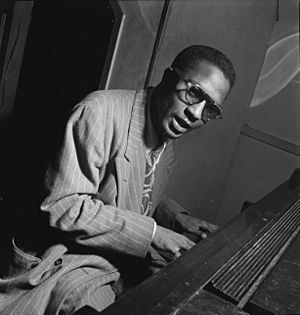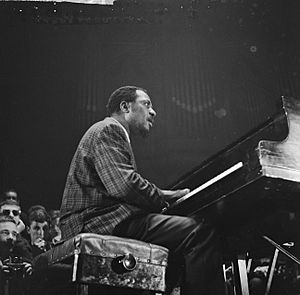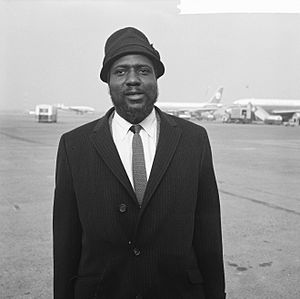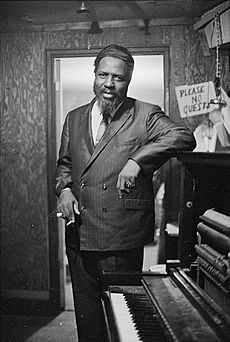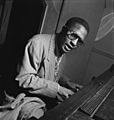Thelonious Monk facts for kids
Quick facts for kids
Thelonious Monk
|
|
|---|---|

Monk at Minton's Playhouse, New York, 1947
|
|
| Background information | |
| Birth name | Thelonious Sphere Monk |
| Born | October 10, 1917 Rocky Mount, North Carolina, U.S. |
| Died | February 17, 1982 (aged 64) Englewood, New Jersey, U.S. |
| Genres | |
| Occupation(s) |
|
| Years active | 1940s–1973 |
| Labels |
|
| Associated acts | |
Thelonious Sphere Monk (/θəˈloʊniəs/, October 10, 1917 – February 17, 1982) was an American jazz pianist and composer. He was known for his unique way of playing and creating music. Monk helped shape the sound of jazz with his many famous songs. Some of his well-known pieces include "Blue Monk" and "Straight, No Chaser".
Monk's music often used interesting sounds and unexpected twists in its melodies. He played the piano in a very distinct way, hitting the keys with a strong, sharp touch. He also used sudden silences and pauses, making his style truly one-of-a-kind.
He had a memorable look, often wearing suits, hats, and sunglasses. During performances, Monk sometimes surprised audiences by stopping playing to stand up and dance for a few moments before returning to his piano. He is one of only five jazz musicians to have been featured on the cover of Time magazine.
Contents
The Early Life of Thelonious Monk
Growing Up and Learning Music (1917–1933)
Thelonious Sphere Monk was born in Rocky Mount, North Carolina, on October 10, 1917. In 1922, when he was five years old, his family moved to Manhattan, New York City.
Monk started playing the piano at age six. He took lessons from a neighbor, Alberta Simmons, who taught him a style called "stride playing." This style was popular with pianists like Fats Waller. Monk's mother also taught him hymns, and he sometimes played for her singing at church. He went to Stuyvesant High School, a special school for talented students, but he did not finish.
For about two years, when Monk was around 10 to 12, his piano teacher was Simon Wolf. Monk learned classical pieces by famous composers like Bach and Beethoven. However, he was most interested in jazz music, so the lessons eventually stopped.
Starting His Music Career (1934–1946)
When he was 17, Monk traveled with a preacher, playing the church organ. In his late teens, he began to get jobs playing jazz music. In the early 1940s, he became the main pianist at Minton's Playhouse, a famous nightclub in Manhattan.
Monk's unique style grew while he played at Minton's. He took part in late-night music battles where many top jazz soloists would show off their skills. Monk's work at Minton's was very important in creating a new style of jazz called bebop. Other musicians like Dizzy Gillespie and Charlie Parker also helped develop bebop. Monk's playing at this time was described as "hard-swinging." He was influenced by jazz legends like Duke Ellington.
In 1944, Monk made his first professional recordings with the Coleman Hawkins Quartet. Hawkins was one of the first well-known jazz musicians to support Monk.
Making Records and Gaining Recognition (1947–1954)
In 1947, Monk met Lorraine Gordon, who became a big supporter of his music. Soon after, Monk made his first recordings as a band leader for Blue Note Records. These recordings showed off his talent for writing original melodies for jazz improvisation.
Monk married Nellie Smith in 1947. They had a son, T. S. Monk, who later became a jazz drummer, and a daughter, Barbara.
At first, Monk's recordings did not sell well. Record store owners sometimes said he "can't play." But Lorraine Gordon believed in his genius. She worked hard to tell everyone about his talent. She even helped him get his first show at the Village Vanguard club.
From 1952 to 1954, Monk recorded for Prestige Records. During this time, he made important albums with other jazz greats like Sonny Rollins and Art Blakey. In 1954, Monk visited Paris for the first time, where he performed concerts and recorded solo piano music.
Rising to Fame (1955–1961)
Monk then signed with Riverside Records. To help more people discover his music, he recorded two albums of jazz standards, which are well-known songs: Thelonious Monk Plays Duke Ellington (1955) and The Unique Thelonious Monk (1956).
In late 1956, Monk recorded Brilliant Corners, which mostly featured his own music. The main song on the album was very complex, but it became Monk's first big commercial success.
In 1957, Monk started a six-month show at the Five Spot Cafe in New York. He led a quartet with John Coltrane on saxophone. This was a very important time for jazz music. Recordings of this group, including a concert at Carnegie Hall, were later released and became famous.
Monk's song "Crepuscule with Nellie" (recorded in 1957) was a special piece. It was written very carefully and was a "love song for Nellie," his wife.
Later Career and Recognition (1962–1970)
In 1962, Monk signed with Columbia Records, one of the biggest record labels. This allowed him to get more attention and promotion. His first Columbia album, Monk's Dream, released in 1963, became his best-selling album ever.
On February 28, 1964, Thelonious Monk appeared on the cover of Time magazine. This was a huge honor and showed how important he had become in music.
During his time with Columbia, Monk continued to record albums like Criss Cross (1963) and Underground (1968). His band during these years included Charlie Rouse on saxophone, Larry Gales on bass, and Ben Riley on drums. This was his longest-lasting band.
Monk's Unique Playing Style
Monk once famously said, "The piano ain't got no wrong notes." This shows his creative and experimental approach to music.
His piano playing was often strong and percussive, even in slower songs. He would hit the keys with his fingers held flat, not curved, which gave his music a distinct sound. Sometimes, it sounded like he was playing with work gloves on! Despite this unusual technique, he could play very fast and accurately when needed.
Monk often used parts of the whole tone scale in his improvisations. He also frequently used parallel sixths in his melodies. His solos often included moments of silence and long notes, which was unusual for jazz pianists of his time. He also liked to play in the key of B flat. Many of his blues songs, like "Blue Monk," were written in this key.
Later Years and Legacy (1971–1982)
By the mid-1970s, Monk began to withdraw from public life due to health issues. He made only a few appearances in his final years. His last studio recordings were made in 1971 during a world tour.
The last six years of Monk's life were spent quietly at the home of his friend, Pannonica de Koenigswarter. He did not play the piano during this time and spoke very little. Thelonious Monk passed away from a stroke on February 17, 1982. He is buried in Ferncliff Cemetery in New York.
The Juilliard School Myth
For many years, it was believed that Thelonious Monk attended the famous Juilliard School of Music. This idea was even mentioned at his funeral and in a documentary about him.
However, there is no real proof that Monk ever studied at Juilliard. The confusion might have come from his piano teacher having a connection to a music school, or from Monk taking part in a music contest around 1942. The first prize for that contest was a scholarship to Juilliard. Monk entered but came in second place. His wife, Nellie, said that when the winner later told Monk he should have won, Monk replied, "I'm glad I didn’t go to the conservatory. Probably would've ruined me." This shows he valued his unique, self-taught style.
Awards and Tributes
Thelonious Monk received many honors for his incredible music:
- In 1993, he was given the Grammy Lifetime Achievement Award.
- In 2006, he received a special Pulitzer Prize for his "distinguished and innovative musical composition that has had a significant and enduring impact on the evolution of jazz."
The Thelonious Monk Institute of Jazz was started in 1986 to honor him. Its goal is to teach jazz music to young people around the world. It helps students think creatively and respect different cultures. The institute also hosts an annual International Jazz Competition. In 2019, it was renamed the Herbie Hancock Institute of Jazz.
Monk was inducted into the North Carolina Music Hall of Fame in 2009.
Musical Tributes
Many musicians have honored Thelonious Monk by performing and recording his music.
- Soprano saxophonist Steve Lacy played with Monk in 1960 and later recorded many albums dedicated entirely to Monk's songs.
- Round Midnight Variations is a collection of new versions of Monk's famous song "'Round Midnight", first performed in 2002.
- John Beasley created a big band called MONK'estra. They play Monk's music with a modern twist, adding different rhythms and styles.
- Jeff Beck's 1975 album Blow by Blow includes a song called "Thelonious," written by Stevie Wonder as a tribute to Monk.
Tribute Albums
Many artists have released entire albums celebrating Monk's music:
- Reflections (1958) by Steve Lacy
- Four in One (1982) by Sphere
- Thelonica (1983), by pianist Tommy Flanagan
- That's The Way I Feel Now: A Tribute to Thelonious Monk (1984), featuring many different rock and jazz musicians.
- Monk Suite: Kronos Quartet Plays Music of Thelonious Monk (1985) by Kronos Quartet
- Carmen Sings Monk (1988) by Carmen McRae
- Monk on Monk (1997) by T.S. Monk (Thelonious's son), featuring many famous jazz musicians.
- Monk's Casino (2005) by pianist Alexander von Schlippenbach; this triple CD set includes every song Monk ever composed.
- Joey. Monk. Live! (2017) by Joey Alexander
- John Beasley presents MONK'estra vol. 1 (2016) and John Beasley presents MONK'estra vol. 2 (2017) by John Beasley
Discography
Images for kids
See also
 In Spanish: Thelonious Monk para niños
In Spanish: Thelonious Monk para niños


